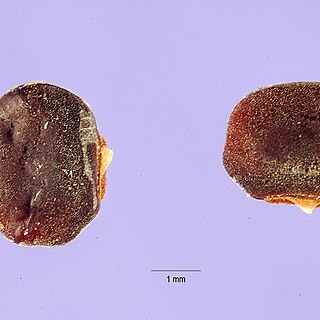A vigorous climbing vine. It is a herb that grows 1.5-2 m high. The leaves have 3 leaflets. They are 14 cm long and 5 cm wide. The flowers are pink, purple or greenish-white. They are 2.5 cm long. They are on stout stalks in the axils of leaves. The seed pods are smooth. They are flat but have both edges raised. They are 25-30 cm long by 1-1.5 cm wide. The seeds vary in shape, size and colour. They can be 1 cm long by 0.7 cm wide. They can be cream or brown. There are small narrow tubers under the ground. They can be 5-7.5 cm long and weigh 50-150 g. The flesh is white and watery.
Leaflets thin, 2.7–13 × 0.2–7.5 cm, ovate, elliptic, ovate-lanceolate or lanceolate, acute to acuminate at the apex, ± rounded at the base, glabrous or sparsely pubescent on the midrib beneath, sometimes with microscopic black speckling; petiole 1.5–8 cm long; rhachis 0.5–2.2 cm long; petiolules 1–4 mm long; stipules 1–5.2 mm long, linear-lanceolate.
Standard creamy to pink or mauve, sometimes with a darker maroon area at the base outside and a greenish-yellow or white basal blotch inside, often edged with pink or purple, 0.5–3.5 × 0.8–4.1 cm, round, deeply emarginate; wings cream-coloured to pink or mauve; keel slightly twisted, white or greenish, sometimes flushed pink or mauve at the apex.
Seeds orange-brown, almost entirely covered with a black suffusion or speckling, 4–7 × 1.9–5.7 × 1.8–5.9 mm, subcylindrical or oblong-ovoid, compressed, microscopically reticulate or shining and sometimes with a few scattered scaly hairs.
Inflorescences 4–9-flowered; rhachis 2–6.5 cm long; peduncles 6–27 cm long; pedicels 0.6–9.7 mm long; bracts and bracteoles deciduous, small, ovate.
Calyx tube 1.8–7 mm long; lobes short, 0.3–3.1 mm long, broad and very rounded, minutely ciliolate.
Perennial prostrate or climbing herb, 1–3 m long from a tuberous rootstock.
Stems often reddish, glabrous or sparsely puberulous, woody near the base.
Pods 4.3–16.3(28) cm × 5–8 mm, linear, margined, glabrous.
Buds green.

